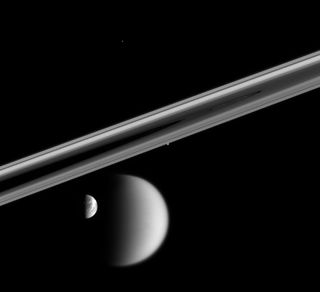NASA's Cassini Saturn Probe Makes Cameo in 'Star Trek: Discovery' Season 2 Premiere

After blasting through the effects-heavy chaos of a "previously on" segment, viewers watching "Star Trek: Discovery" last night (Jan. 17) were treated to a more realistic, awe-inspiring view of Saturn's rings, courtesy of the real-world Cassini spacecraft.
The episode begins with a voice-over from the character Michael Burnham, played by Sonequa Martin-Green: "Space, the final frontier. Above us, around us, within us. We have always looked to the stars to discover who we are." As a backdrop to her words, the show airs black and white images from NASA's Cassini spacecraft, which returned beautiful views of the Saturn system before the mission ended with a "grand finale" dive into the ringed planet in 2017. The show puts an old-looking slideshow introduction before the photos, but they are our modern-day best views of Saturn's spectacular rings and moons.
"What I love about that opening is that it jumps you into this incredible bird's-eye-view perspective on how small we are in the universe and how massive the cosmos are," Alex Kurtzman, the series' showrunner, told Mike Bloom in The Hollywood Reporter. "The show is called 'Discovery' for a reason. Burnham is going to be wrestling this season with her place in the universe and what her purpose is." [Cassini's Greatest Hits: The Spacecraft's Best Images of Saturn]
In the "Star Trek" universe, the footage from Cassini, in particular, "is archaic, the old way we used to look at space," he told The Hollywood Reporter. "Look how we evolved; look at how our understanding of and our place in the universe changes. I felt that was all embedded in that story, and I loved the visuals and emotional representation."
The footage helps ground (metaphorically!) the episode — while the technology and circumstances may be fantastical, the character interactions and the sense of wonder at the cosmos echo the real world and real human potential. Even if Cassini is ancient history in "Star Trek" terms, it still offers the same inspiration.
This isn't the first Cassini connection to "Star Trek." Carolyn Porco, a planetary scientist at Space Science Institute in Boulder, Colorado, who led Cassini's imaging science team, also acted as the official science consultant for the 2009 "Star Trek" film, contributing to a scene in which the Enterprise rises through the haze of Saturn's moon Titan.
After the Cassini interlude and Burnham's reflection on an ancient story about the Milky Way's creation, the story jumps into high gear, with (among other things) a daring attempt to scoop a sample from a mysterious interstellar asteroid. Is it too much to speculate that this ends up being the recently discovered 'Oumuamua? It could journey pretty far in a couple centuries.
Get the Space.com Newsletter
Breaking space news, the latest updates on rocket launches, skywatching events and more!
Email Sarah Lewin at slewin@space.com or follow her @SarahExplains. Follow us on Twitter @Spacedotcom and on Facebook. Original article on Space.com.
Join our Space Forums to keep talking space on the latest missions, night sky and more! And if you have a news tip, correction or comment, let us know at: community@space.com.

Sarah Lewin started writing for Space.com in June of 2015 as a Staff Writer and became Associate Editor in 2019 . Her work has been featured by Scientific American, IEEE Spectrum, Quanta Magazine, Wired, The Scientist, Science Friday and WGBH's Inside NOVA. Sarah has an MA from NYU's Science, Health and Environmental Reporting Program and an AB in mathematics from Brown University. When not writing, reading or thinking about space, Sarah enjoys musical theatre and mathematical papercraft. She is currently Assistant News Editor at Scientific American. You can follow her on Twitter @SarahExplains.
